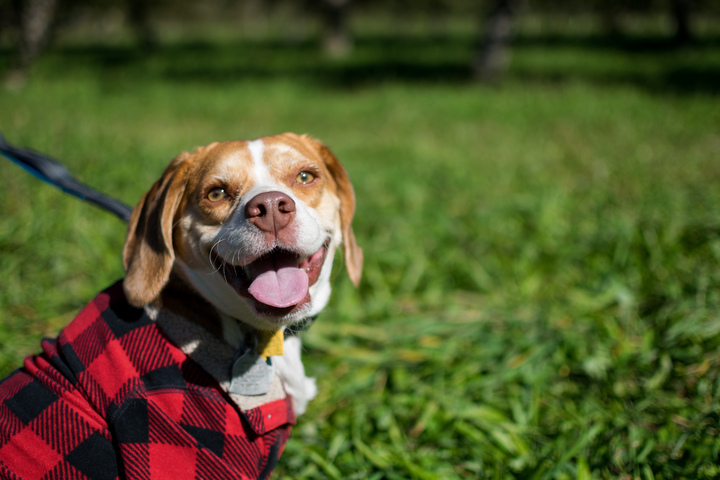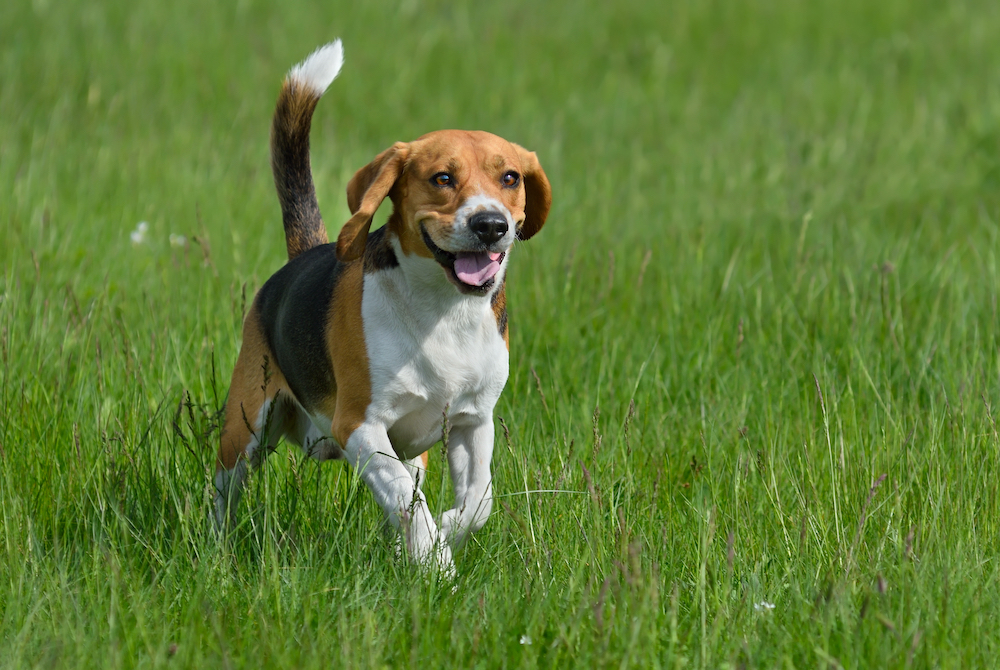Big eyes that you’ll get lost in. Long ears that flap in the wind. A booming voice and a penchant for baying. There’s no mistaking the beagle. The breed is famously represented in pop culture via the iconic cartoon dog Snoopy. Yes, Charlie Brown’s best friend is a beagle, though he’s not drawn photorealistically.
A word that Beagle owners frequently use to describe their pets is “merry.” They are friendly, affectionate and outgoing. Maybe those qualities are why a beagle was chosen to be the Mascot of the American Kennel Club.
While beagles are typically cheerful and even-tempered, they are also active dogs who can be strong-willed and require patience to train. It’s very important that they get lots of exercise and training from the start. And, of course, because every dog is an individual, your beagle’s behavior may not be what’s considered “typical” of the breed.
Whether you have a beagle or are thinking of getting one, here are some of the most important things to know about these doe-eyed, energetic dogs.

Oliver
Beagle breed history
We’re not certain exactly when the beagle became “the beagle”—but the scent hound’s ancestors were popular in England by the 16th century, when humans used them to track hares. They’ve been employed as hunting dogs ever since, and the strong noses, determination, and booming voices that make them good at that job can sometimes be challenges for those who keep them as companions. Even if your beagle doesn’t have an official job, it’s important to remember their roots and harness their natural talents in a way that works for both of you; trying to suppress their nature could lead to a miserable dog and a frustrated owner.
The Merriam-Webster dictionary says the word “beagle” is derived from the Middle English begle, and Oxford Languages says its name may have come from the Old French word beegueule, which combined “open wide” and “throat.” Considering the breed’s vocal reputation, this seems plausible.
A sport called beagling became very popular in Britain and Ireland in the 18th century. In the activity, a pack of beagles tracks the scent of rabbits or hares, followed by people on foot. A handful of UK colleges and universities, including Eton, Oxford, and Cambridge, still have their own beagle packs today. Since the 2004 Hunting Act banned the actual hunting of hares and rabbits in the UK, dogs participating in beagling track a pre-laid, hare-scented trail.
Today, you’re more likely to find a beagle as a companion animal in a family home; the AKC lists them as the eighth most popular breed in the United States as of 2022.
Sadly, beagles are also sometimes mistreated, including in cruel experimental conditions. Last year, we covered the story of 4,000 beagles who were rescued from a mass breeding facility in Virginia, and the efforts to find them loving homes.
Besides Snoopy, many more beagles—real and fictional—have achieved cultural prominence. For example: the live-action version of dog superhero Underdog was a beagle, and President Lyndon Johnson kept pet beagles in the White House.

Ernie
Breed stats and info
The AKC recognizes two sizes of beagle; the smaller variety weighs under 20 pounds and is less than 13 inches tall, whereas the larger type is 20–30 pounds and stands 13–15 inches in height. Beagles’ average lifespan is around 10–15 years.
While a beagle’s most recognizable coloring may be the tri-color of red, black, and tan, the AKC lists 25 different color combinations—mixing hues including tan, white, lemon, brown, black, bluetick, and red. Factor in variations of shades and markings, and the possibilities are practically endless; no two beagles look exactly alike. Another common feature of beagles is a white-tipped tail, whether that means just a few white hairs right on the tip or a patch that takes up half of the tail. Beagles are also known for their long, floppy ears—which aren’t just for looks. They actually help the dogs follow a trail by catching scent particles and keeping them close to their nose for sniffing.
Beagles have short fur—but they still shed. They are double-coated dogs, which means they can keep themselves warm in colder temperatures and cool in warmer ones. Their fur is short and prickly, and definitely not hypoallergenic.
Their nose knows (a lot)
Even in the canine kingdom, where astonishing olfaction is the norm, Beagles have exceptionally good noses. Because they can track the faintest odors and scents that are hours old, beagles tend to thrive in pursuits that put their noses to work. They excel in the search-and-rescue field and drug detection. They are often found in airports sniffing out prohibited food items that could carry pests and disease into the United States. Outside of these jobs, some beagles’ noses can go even further—one study found that they could detect lung cancer in humans with 97% accuracy.

While beagles’ amazing sense of smell can be put to great use, it can be a source of frustration for a human companion who’s looking to get from point A to point B in the shortest time possible. Their impressive noses can lead them to whatever goodies are in the garbage bin or on the street, despite your efforts to keep them moving along. Many a beagle’s human uses the term “selective hearing” to capture their talent at ignoring anything besides their chosen smell. It’s not unusual for a beagle to become ultra-focused and obsessed with a scent, which makes it difficult to let them off leash unless their recall training is impeccable. No dog is fully predictable, so you can’t be sure that your beagle won’t follow a particularly enticing odor even if you’d rather they didn’t. “We do not recommend off-leash with them,” says Leann Tenbusch of Triangle Beagle Rescue in North Carolina. “Their noses are so sensitive… all can be well, but then a squirrel runs across their path and they forget everything. It’s just what they do.”
Sometimes walking a beagle can feel like it’s taking an eternity—just ask Han Thazin Tun, who has a beagle named Oliver. “If you think your dogs sniff on walks, think again,” she says. “Oliver has to stop every two steps to sniff for what feels like hours. If we went on walks at his pace, I would never come back from a single walk!” So if you do want to get a beagle, prepare to leave plenty of time for morning walks. While every dog should learn how to walk properly on leash, and a nice, brisk walk can be good for physical fitness, it’s important to let your pup exercise their natural sniffing ability. Make sure to give your beagle time to smell plants, sidewalks, fire hydrants, and anything else safe that interests them. You may not see anything fascinating there, but smelling is a rich source of mental exercise for dogs.
In addition to giving beagles ample sniffing time, you may want to look into other ways to encourage the constructive use of their talents. This could mean organized scent work, or at-home or backyard brain games that allow them to find favorite treats or toys. If you give your beagle enough acceptable outlets for their superpowered snout, they will be less likely to invent their own, less-appealing jobs.
Beagle personality and training
Every dog is an individual, and dogs of the same breed can and do have very different personalities. If your beagle behaves in ways that you don’t expect, that doesn’t mean anything is wrong with them. However, there are certain tendencies that many beagle lovers notice in their pups.
Beagles are typically known as fun-loving dogs and great companions. Usually they are friendly, great with children, and very affectionate. As such, they are popular family dogs. They are also typically sociable and docile, which means they’ll be easygoing around other dogs, and frequently want to stop and say hello to humans. However, every dog needs training, and you should always supervise children and dogs when they’re together. Tenbusch says that, despite beagles often getting along well with kids, her rescue doesn’t usually adopt beagle puppies out to families with children younger than five years old. “Any puppy is going to bite and grab [a child’s] hand,” she says of puppies’ tendency to use their mouths. “The kid is going to scream and run,” she continues, “and the dog will chase.”
Humans who live with beagles also report some more challenging traits. Beagles can be stubborn, high energy, and very vocal. Like many other hounds, they love to express themselves via sound. Elizabeth Gilbert says of her beagle, Ernie: “That beagle bay is one of a kind, though not so adorable at 5 in the morning when the neighbors are sleeping.” With patience, you can work to reduce your beagle’s unwanted barking; but know that you can expect some vocalization. If silence is a priority for you, you may have trouble living in harmony with many beagles.
It’s not advisable to get a beagle puppy if a very vocal dog will create issues for you, but you may have better luck with an adult dog that’s already proven to be on the quieter side. “All of our dogs are in foster homes,” Tenbusch says, “so when someone is interested in this cute picture of Buttons, we send them to Buttons’ foster, and they ask ‘What’s up with Buttons?’” She continues: “They’re going to tell them—Will they howl? Then you shouldn’t have them in an apartment, probably.” If you know the people who’ve been looking after a dog, ask as many questions as you can about their needs and habits. And don’t expect miracles—if an ambulance passes or another dog is howling nearby, even a trained, usually quiet beagle is liable to get a word in.
Again, think long and hard before letting your beagle roam off leash. Tenbusch doesn’t recommend it. Any dog needs great recall to be trusted in an environment with distractions, and beagles’ powerful noses and independent spirits can further complicate matters. Also watch exits to your home, car, or wherever else you are keeping a beagle—if they smell something interesting, they’ve been known to dash out of doors or windows.
It’s important to start training early, and direct beagles’ natural instincts toward safe pastimes. It can be challenging to hold your beagle’s attention as you compete with all of the scents out there. But they are very smart and eager to please—so if you work with a trusted trainer, remain consistent, and show your dog lots of patience and kindness, you will make progress.

Your beagle may be a “velcro dog”
One thing that most Beagle owners can agree on is that they love to be around their human families. Some have been known to follow their humans from room to room. This is adorable when you’re all together—but be on the lookout for signs of separation anxiety. If your beagle is having trouble being left by themselves, they’ll let you know it—you may hear howling or see signs of destruction. They may also show signs that they’re upset when they sense that you’re about to leave. If your dog has separation anxiety, do what you can to help them; not only can the noise and property destruction be inconvenient for humans, but the psychological toll can be anguishing for dogs. More physical and mental exercise, counterconditioning, and crate training can all be part of easing a dog’s difficulty with time alone. Because every dog is different, it may take time to find what works for your pup. If you’re struggling, don’t hesitate to seek out a qualified trainer or behaviorist.
“I chose Mr. Needy. I didn’t know that [a beagle’s] howl was so loud. He does not like to be left alone! But now that he’s older and knows our schedules, he’s a lot better. He will let you know if he’s not happy with any changes by peeing and pooping in the house. Miles loves hugs and cuddles, but does not like to take a bath.”
– Sylvia McGrath about her beagle, Miles
Exercise for beagles
Beagles also need an ample amount of daily activity. Even if they are not employed, they are still working dogs. A bored and under-exercised beagle is more likely to become overweight and destructive in the home. Beagles have a ton of energy to burn—they need long walks with time for sniffing, running or playing in an enclosed area, and a lot of mental stimulation. Providing them with the exercise they need, both physically and mentally, will make for a happier, calmer dog.
Beagles instinctually love to use their noses. Hide-and-seek, puzzles, snuffle mats, and scent work are among the fun and satisfying ways to let them do so. Satisfying a beagle’s impulses to track down scents will be paramount in helping them stave off boredom and their inclination to rummage around the house looking for trouble.
“We all have to rush to appointments,” Tenbusch acknowledges, so not every walk can be an olfactory marathon. “You can take them around the block” when you’re in a rush, she says, as long as you “later let them lollygag around the park so they can sniff.”

Common beagle health concerns
Along with ailments common to all dogs—such as dental disease and cancer—beagles are at particular risk for the following:
Obesity: If left to their own devices, Tenbusch says, “beagles will eat themselves silly.” It’s important to feed your beagle only the proper portions of their balanced food and get them sufficient exercise, as research has found that they are especially prone to becoming overweight or obese. Obesity is linked to a whole raft of health problems, including arthritis, chronic kidney disease, bladder/urinary tract disease, liver disease, low thyroid hormone production, diabetes, heart failure, high blood pressure, and cancer—so keeping your beagle in an ideal body condition is one way that you can give them a better shot at a long, healthy life.
Cherry eye: This is a condition in which the nictitating membrane, also known as the third eyelid, prolapses. This means that the membrane, which is usually hidden in the corner of a dog’s eye, bulges out, resulting in a large pink mass protruding from the eye. Treatment usually requires surgery.
Dry eye: This is a painful condition in which the protective film that covers and protects the eye develops an abrasion. Abrasions can develop due to lack of adequate moisture to lubricate the eye. Dry eye can be a complication of cherry eye.
Glaucoma: In dogs with this disease, high pressure in the eye damages the optic nerve and retina. This can lead to reduced vision and blindness. Symptoms include eyeball protrusion, redness, pain, and light sensitivity.
Distichiasis: In this painful condition, extra hairs grow inside of a dog’s eyelids and rub on the surface of their eyes. If untreated, these hairs can cause corneal ulcers. Treatment options include lubricating the eyes and permanently removing the abnormal hairs.
Ear infections: Beagles have long, floppy ears that cover the ear canal and easily trap moisture, creating an environment that’s dark and damp—an inviting place for bacteria and yeast to grow. Symptoms of an ear infection can include head shaking, scratching at the ears, thick wax, and an unappealing odor. To prevent ear infections, it’s important to maintain good hygiene. For tips, check out our guide to caring for your dog’s ears.
Idiopathic epilepsy: Beagles are prone to this brain disorder, in which sudden electrical surges can cause seizures. There is no known cause, though researchers suspect it may be inherited. Before a seizure, dogs may hide or seek out their owners for comfort. During a seizure, which usually lasts for less than a minute, a dog may collapse, become rigid, or flex and extend their joints. If you see your dog having a seizure, carefully keep them safe from objects that could cause injury, but stay away from their mouth, as they might bite you inadvertently. Keep track of how long the seizure lasts and call your vet (or an emergency vet if it’s after hours). After the seizure, your dog may be disoriented or sleepy. Idiopathic epilepsy is often treated with anti-seizure medicine.
Intervertebral disc disease (IVDD): In this degenerative condition, dogs’ intervertebral discs—pieces of cartilage and other tissue between the vertebrae of their spine—herniate. Signs may include dragging or weakness of the hind limbs, reluctance to move, a hunched back or neck, or crying out in pain. If you notice any of these symptoms, bring your dog to the vet immediately—prompt treatment can make a huge difference in their prognosis. It’s not possible to guarantee that your dog will never develop IVDD, but you can improve their chances of good spinal health by keeping them in an ideal body condition and not letting them jump off of furniture.

Food and nutrition for beagles
As with any breed of dog, it’s important to feed beagles healthy, complete and balanced food on a regular schedule.
Allergies and sensitivities: Alleviating or eliminating the triggers to a canine food sensitivity requires identifying the culprits, which can include certain proteins, artificial colors, and other ingredients. Your vet can help with this investigation. Finding a diet that’s compatible with your pet’s allergies might mean trying an elimination diet. But it might also mean avoiding dry, highly processed food. Many commercial dog foods contain a long list of ingredients, and it’s not always clear what all of them are. One study of commercial, over-the-counter processed dog food showed that unlisted ingredients appeared in 13 out of 14 brands tested.
Support joint health: A fresh diet that provides balanced omega-3 fatty acids may help keep joints healthy. A pre-portioned fresh food plan also makes it easy to feed the right number of calories every day. This helps maintain a healthy weight, which is another key factor in keeping joints healthy, as well as improving general health and quality of life.
Mind the teeth: Eating for dental health means eating for overall health. A fresh, whole-food diet promotes a healthy immune system, which helps ward off dental maladies.
High-quality food for high-quality poops: A diet of fresh, lightly cooked food has been shown to be more digestible than processed kibble, and can promote a healthy gut and good digestion (which also means better, smaller poops).
Where to get a beagle
If a beagle sounds like the dog for you, consider rescuing one from a local shelter. The Beagle Freedom Project, SOS Beagle Rescue, Triangle Beagle Rescue, and Bernard’s Beagle Rescue are just some of the places where you can find a beagle in need of a loving home.









